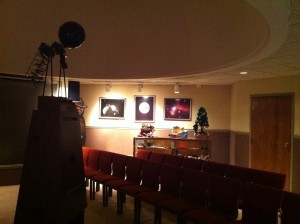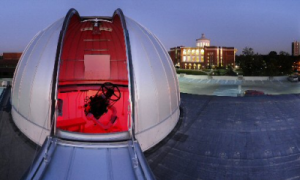
Dome covers at Kjell Henriksen Observatory. Image courtesy of KHO.
If I had known when I left my hometown (latitude: 48.71 N) that I would never see the northern lights again, maybe I wouldn’t have been in such a hurry to get out of the valley. Or maybe I would have—I hated the northern lights when I was a kid (seriously), so I might not have thought it would be much of a loss. Now that I know that relatively few people see the northern (or southern) lights and I’ll be lucky to see them again….yeah. Bad decision.
The aurora borealis are on my mind this week because almost every person* I follow on twitter has been obsessing over the ongoing solar storms. Last’s week’s solar flare was a bust for aurora viewing in my part of the world and I don’t think the newest flare is going to produce anything for us, either. The collective wisdom of twitter is saying otherwise, but we live so far south that I’d be afraid of any solar flare/coronal mass ejection that released enough charged particles to light up our night skies.
So, this just makes me wonder: do the scientists at the Kjell Henrikson Observatory (KHO) in Svalbard, Norway, know they have the best job in the world? Yes, they have to keep an eye on the polar bears and it probably isn’t fun dealing with arctic temperatures, but they get a pretty good reward for all that suffering: not only can they study ‘nightside’ aurora at the observatory, but they can also study ‘dayside’ aurora. I’ve only seen nightside aurora, which appear on the side of Earth opposite the sun. Nightside aurora can be very bright and colorful, and in my experience, very active—they pulse, wave, dance, however you want to describe it. Dayside aurora, on the other hand, haven’t been energized by Earth’s magnetic field, so are allegedly much calmer.**

AGF-345 field work by Njål Gulbrandsen. Photo courtesy KHO.
If you’d like some inspiration for winter observing, visit the KHO homepage. The ‘History’ tab details the development of optical observations of aurora, but I found the entries in the ‘Documents’ section much more interesting, particularly the document about Kjell Henrikson, Polar Bear on a Hot Tin Roof. My architecture students should check out the technical drawing of KHO and the other construction documents (including the construction photos, click on the ‘Image Gallery’ tab). Everybody should watch the dome removal videos: Safe Turtle Mode and Scared Turtle Mode.
————–
*The cats, deer, squirrel and robots I follow on twitter haven’t expressed any interest in the northern lights.
**I’d refer to you the January 1997 Discovery article on dayside aurora, but the online edition doesn’t include the photos, so what’s the point?











